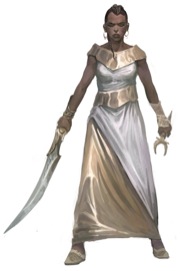Alright everyone, this is the last blog before Pathfinder Unchained hits your local stores! Many of you have heard so far that with Unchained, we’re encouraging you to really experiment and play around with the system, so we thought we’d end with a bang and release information about two of the pieces of Unchained that we hadn’t previewed yet as well as give you even more content! That’s right, Unchained was so full to the brim with exciting rules changes and optional subsystems, that it couldn’t even fit it all. So let’s take a look at what we’ve got.
First up is Automatic Bonus Progression. If you’re like me, you’ve probably been annoyed at some point or another that your characters more-or-less need to purchase certain magic items to keep up with the game’s math, and those items are super-generic and just add numbers. Why not take out the middle man and just give you what you need to keep up with the numbers, thus letting you be creative with where you spend the rest of your wealth, on fantastic and truly wondrous items. As the newbie designer, one of the first things I added to any of our books was a subsystem to do just that, and the subsystem in the book is an excellent addition to games that have low magic items as well! There are even rules to explain how automatic enhancement bonuses on weapons and armor will interact with special properties, like flaming. The system in the book is simple to adjudicate and curbs some of the potential problems with things like buying tons of different weapons with different iterations of the bane property (or making special qualities the workaround to boost your numbers ahead of everyone else, since you wind up making a trade-off). Take a look at this alternate approach, which allows you to follow the same mathematical progression for special properties, in exchange for using the table below.
Magic Weapons and Armor
Magic weapons and armor using this system never grant an enhancement bonus but instead grant only special qualities (up to a maximum of +5). Any quality that costs a flat amount is unchanged, but qualities that have an enhancement bonus equivalent use a slightly modified pricing system.
In this system, independent magical effects on weapons and armor can sometimes interfere with the process of attuning to the item. Therefore, each magic weapon and armor has a capacity, from 0 to 5, which indicates how much of a character’s attunement can apply to that weapon or armor. Any character who attunes to a magic weapon or armor gains an enhancement bonus equal to the minimum of her attunement and the item’s capacity. Increasing a weapon’s capacity requires a crafting cost of 2,000 gp x the total enhancement bonus of the weapon’s special abilities (and a market price of twice that). Upgrading a weapon that has a capacity greater than 0 requires paying the difference in the cost of the capacity. So for instance, a flaming weapon with capacity 0 has a crafting cost of 1,000 gp. Upgrading its capacity to 3 would cost 6,000 gp. If the crafter later wanted to upgrade the capacity 3 flaming weapon to flaming burst, it would cost 3,000 gp to upgrade flaming to flaming burst and an additional 6,000 gp because the capacity’s cost increases when the weapon’s enhancements increase for a total of 9,000 gp. In total, this weapon cost 16,000 gp to make and has a market price of 32,000 gp. Armor works exactly the same, but all costs are half as much.
| Weapon Prices | ||||||
|---|---|---|---|---|---|---|
| Enhancement | 0 capacity | 1 capacity | 2 capacity | 3 capacity | 4 capacity | 5 capacity |
| +1 | 2,000 | 6,000 | 10,000 | 14,000 | 18,000 | 22,000 |
| +2 | 8,000 | 16,000 | 24,000 | 32,000 | 40,000 | 48,000 |
| +3 | 18,000 | 30,000 | 42,000 | 54,000 | 66,000 | 78,000 |
| +4 | 32,000 | 48,000 | 64,000 | 80,000 | 96,000 | 112,000 |
| +5 | 50,000 | 70,000 | 90,000 | 110,000 | 130,000 | 150,000 |
| Armor Prices | ||||||
|---|---|---|---|---|---|---|
| Enhancement | 0 capacity | 1 capacity | 2 capacity | 3 capacity | 4 capacity | 5 capacity |
| +1 | 1,000 | 3,000 | 5,000 | 7,000 | 9,000 | 11,000 |
| +2 | 4,000 | 8,000 | 12,000 | 16,000 | 20,000 | 24,000 |
| +3 | 9,000 | 15,000 | 21,000 | 27,000 | 33,000 | 39,000 |
| +4 | 16,000 | 24,000 | 32,000 | 40,000 | 48,000 | 56,000 |
| +5 | 25,000 | 35,000 | 45,000 | 55,000 | 65,000 | 75,000 |
But wait! There’s more! Early in the Unchained process, we decided to give you tons of sample monsters that use the new system. Later on, we realized that it would be even cooler if we also gave you step-by-step explanations of how we built them, to maximize your ability to make more of your own. You can guess what came next—explanations made each monster longer, so we had to cut a bunch of monsters. Well, the mighty tarrasque has something to say about that. It will not be chained. And while you read its mighty stats, here’s a flumph with laser beams!
Tarrasque CR/HD 25
Init +6; Perception +45 (low-light vision, scent)
Aura (DC 28) frightful presence (300 ft.)
Size Colossal (30 ft.); Speed 40 ft.; Special Movement rushDEFENSES
AC 45 (touch 19, flat-footed 39); Fort +26, Ref +26, Will +21; CMD 58 (62 vs. grapple); SR 36
hp 616; regeneration 40 (cannot be suppressed, automatically rises from death after 3 rounds); DR 15/epic; Immune ability damage, ability drain, acid, bleed, daze, disease, energy drain, fire, mind-affecting effects, paralysis, permanent wounds, petrification, poison, polymorph, staggered
Defensive Options carapaceATTACKS
Melee bite (reach 30 ft.) +38 (4d8+19/15–20/3 plus improved combat maneuver [grapple]), 2 claws (reach 30 ft.) +38 (4d8+19), 2 gores (reach 30 ft.) +38 (4d8+19), tail slap (reach 60 ft.) +33 (4d6+9)
Ranged 6 spines (range 120 ft.) +30 (2d10+22/19–20/3)
Attack Options (DC 46) critical striker, defense breaker, pounce, swallow whole (10d6+29 plus 10d6 acid), trample (12d8+51); CMB +56 (+60 grapple)STATISTICS
Str +16, Dex +6, Con +12, Int –4; Acrobatics +45 when jumping
XP 1,638,400; N magical beastSPECIAL ABILITIES
Carapace (Su) The tarrasque’s carapace deflects cones, lines, ranged touch spells, and magic missiles automatically, with a 30% chance to reflect them onto the caster.
Rush (Ex) Once per minute, the tarrasque can increase its speed to 150 feet for 1 round. This also doubles its bonus on Acrobatics checks when jumping.
The mighty tarrasque has a special DR type of epic, and a slew of special immunities. As it is the tarrasque, it has many more combat options than normal, and it has its own non-standard suite of attacks based on the expected damage (for instance, the 6 spines each do 1/3 of the damage for 2 primary natural attacks). The tarrasque’s spines and bite have a ×3 critical multiplier, and the bite has a natural 18–20 threat range before adding the critical striker option. The tarrasque also has two master skills instead of one master and two good (and one of the two is only at master level when jumping).
Well, that about wraps up our previews for Pathfinder Unchained! This book is shipping to subscribers now, and you should be able to find it in your local gaming store next week! Pick it up and unchain your game!
Mark Seifter
Designer









